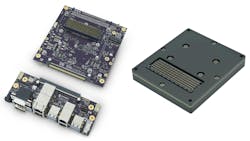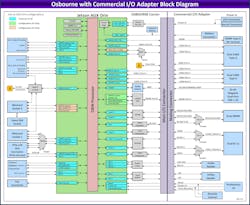Modular AGX Orin Carrier Board Speeds Prototyping
What you'll learn:
- Why use Osbourne instead of NVIDIA's development kit?
- Why include a connector board?
Diamond Systems' Osbourne carrier board is design to host NVIDIA's popular AGX Orin module (see figure). The AGX Orin is designed to provide artificial intelligence (AI) at the edge for real-time implementation of large language models (LLMs) and other AI models.
The module is available as part of the NVIDIA development kit that I've looked at, but it falls short as a practical platform for deployment. Essentially, it's not as good a prototyping platform for rugged hardware development. This is where the Osbourne shines.
The Osbourne is actually a pair of boards that mates with an AGX Orin module. The main carrier board plugs into a connector board that's ideal for prototyping. It could be used in a production environment, but typically this would be replaced with a custom board that has only the necessary interfaces for an application.
The main carrier board includes an M.2 E key and M.2 M key socket. which tend to be the more difficult interfaces to design. However, the connectors are relatively easy to implement in a custom board. The carrier board and connectors support these interfaces:
- 3x USB 3.2 ports
- 4x USB 2.0 ports
- 1G/2.5G/5G/10G Multi-Gigabit Ethernet port
- 10/100/1000-Mb/s Ethernet port
- 4 x4 or 8 x2 lane CSI-2 camera interface using industry-standard adapter socket
- 2x software-configurable RS-232/422/485 ports with TTL option on one port
- 2x fixed RS-232 ports
- HDMI 2.0a/b directly from Orin module
- Audio I/O via ALC5640 CODEC
- 8x digital I/O via I2C I/O expander
- 2x CAN 2.0 ports with non-isolated transceivers
- 2x mPCIe full-size sockets with PCIe and USB support
- M.2 M key (2280 or 2242) NVMe expansion slots (4 lane PCIe Gen 3)
- M.2 E key 2230 socket
The AGX Orin is a system-on-chip (SoC) that incorporates a 1.3-GHz GPU with 2048-core NVIDIA Ampere cores and 64 Tensor Cores. It can deliver 275 TOPS of performance to significantly boost AI performance. It also has a multicore Arm Cortex-A78AE processor complex along with onboard eMMC memory.
Related Links
A Hands-On View of NVIDIA's Jetson AGX Orin
More Rugged Systems
About the Author
William G. Wong
Senior Content Director - Electronic Design and Microwaves & RF
I am Editor of Electronic Design focusing on embedded, software, and systems. As Senior Content Director, I also manage Microwaves & RF and I work with a great team of editors to provide engineers, programmers, developers and technical managers with interesting and useful articles and videos on a regular basis. Check out our free newsletters to see the latest content.
You can send press releases for new products for possible coverage on the website. I am also interested in receiving contributed articles for publishing on our website. Use our template and send to me along with a signed release form.
Check out my blog, AltEmbedded on Electronic Design, as well as his latest articles on this site that are listed below.
You can visit my social media via these links:
- AltEmbedded on Electronic Design
- Bill Wong on Facebook
- @AltEmbedded on Twitter
- Bill Wong on LinkedIn
I earned a Bachelor of Electrical Engineering at the Georgia Institute of Technology and a Masters in Computer Science from Rutgers University. I still do a bit of programming using everything from C and C++ to Rust and Ada/SPARK. I do a bit of PHP programming for Drupal websites. I have posted a few Drupal modules.
I still get a hand on software and electronic hardware. Some of this can be found on our Kit Close-Up video series. You can also see me on many of our TechXchange Talk videos. I am interested in a range of projects from robotics to artificial intelligence.




